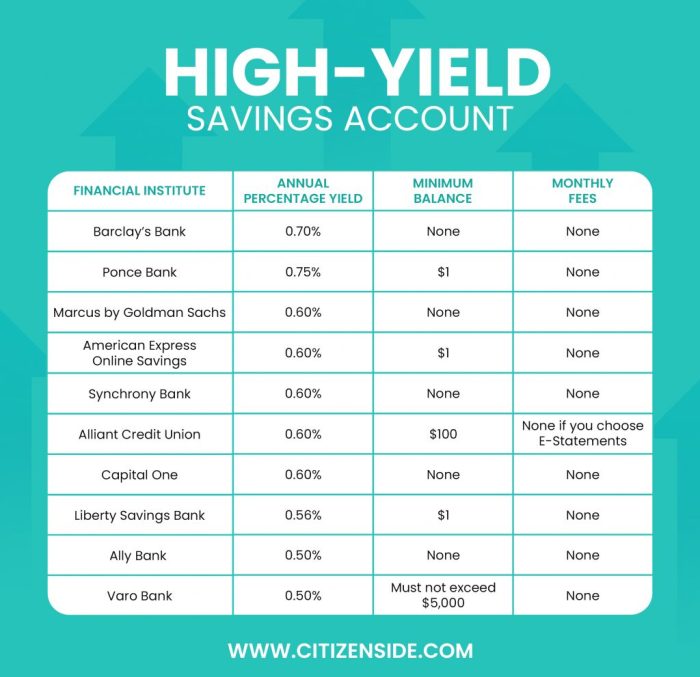Get ready to dive into the world of high-yield savings accounts, where your money can grow faster than you ever imagined. From understanding the basics to maximizing your savings potential, this guide will take you on a journey towards financial success.
Let’s explore how high-yield savings accounts work, what factors to consider when choosing one, and how the interest rate can impact your savings growth.
What are high-yield savings accounts?
High-yield savings accounts are a type of savings account that typically offer higher interest rates compared to traditional savings accounts. These accounts are usually offered by online banks or financial institutions and are designed to help individuals grow their savings faster.
Examples of financial institutions offering high-yield savings accounts
- Ally Bank
- Synchrony Bank
- CIT Bank
- American Express National Bank
Benefits of high-yield savings accounts compared to traditional savings accounts
- Higher interest rates: High-yield savings accounts offer better interest rates, allowing your savings to grow faster over time.
- No monthly fees: Many high-yield savings accounts don’t have monthly maintenance fees, helping you keep more of your savings.
- Easy access: Despite being offered by online banks, high-yield savings accounts often provide easy access to your funds through online and mobile banking platforms.
- Federal insurance: Just like traditional savings accounts, high-yield savings accounts are typically insured by the Federal Deposit Insurance Corporation (FDIC) up to a certain limit, providing security for your savings.
How do high-yield savings accounts work?

When it comes to high-yield savings accounts, understanding how they work can help you make the most of your savings. These accounts offer a higher interest rate compared to traditional savings accounts, allowing your money to grow faster over time.
Interest Calculation in High-Yield Savings Accounts:
Interest in high-yield savings accounts is typically calculated daily and compounded monthly. This means that the interest you earn is added to your account balance each month, and then future interest is calculated based on the higher balance, helping your savings grow faster.
Requirements and Restrictions:
While high-yield savings accounts offer higher interest rates, they may come with certain requirements or restrictions. Some accounts may have a minimum balance requirement to earn the high yield, while others may limit the number of withdrawals you can make each month without incurring a fee. Be sure to read the fine print and understand any limitations associated with the account.
Tips for Maximizing Benefits:
To make the most of a high-yield savings account, consider the following tips:
– Regularly contribute to your account to maximize the interest earned.
– Take advantage of any bonus interest rates or promotional offers.
– Set up automatic transfers from your checking account to ensure consistent savings.
– Compare different high-yield savings account options to find the best fit for your financial goals.
What factors should one consider when choosing a high-yield savings account?
When choosing a high-yield savings account, there are several key factors to consider to ensure you are getting the most out of your savings. From interest rates to fees, it’s important to weigh your options carefully.
Key Features to Look for in a High-Yield Savings Account
- Competitive Annual Percentage Yield (APY): Look for accounts with high APY to maximize your earnings over time.
- Liquid Access: Ensure that you have easy access to your funds without facing withdrawal penalties or restrictions.
- Low or No Fees: Opt for accounts with minimal fees to avoid eating into your savings.
- FDIC Insurance: Make sure your funds are protected by the Federal Deposit Insurance Corporation (FDIC) for added security.
Importance of APY in Selecting a High-Yield Savings Account
APY plays a crucial role in determining how much interest you earn on your savings. A higher APY means your money grows faster, so it’s essential to choose an account with a competitive rate to make the most of your savings.
Remember, even a small difference in APY can result in significant earnings over time, so it’s worth comparing rates before making a decision.
Comparison of Fees Associated with Different High-Yield Savings Accounts
| Account | Monthly Maintenance Fee | Excess Withdrawal Fee |
|---|---|---|
| ABC Bank Savings | $5 | $10 per withdrawal after 6 withdrawals |
| XYZ Credit Union Savings | No monthly fee | $5 per withdrawal after 3 withdrawals |
Comparing fees is essential to avoid unnecessary charges that can eat into your savings. Look for accounts with low or no fees to maximize your earnings.
How does the interest rate of high-yield savings accounts impact savings growth?
When it comes to high-yield savings accounts, the interest rate plays a crucial role in determining how quickly your savings can grow over time. A higher interest rate can significantly accelerate the growth of your savings compared to traditional savings accounts.
Higher Interest Rate Accelerates Savings Growth
- With a higher interest rate, your savings will earn more money over time, allowing your balance to increase at a faster pace.
- This accelerated growth is especially beneficial for long-term savings goals, such as building an emergency fund or saving for retirement.
Examples of Interest Rate Impact on Savings
- For example, let’s say you deposit $10,000 in a high-yield savings account with a 1% interest rate. After one year, you would earn $100 in interest.
- Now, if the interest rate increased to 2%, you would earn $200 in interest after the same amount of time, doubling your earnings.
Compounding Interest and High-Yield Savings Accounts
- High-yield savings accounts often offer compound interest, where the interest is calculated on both the initial deposit and the interest that has already been earned.
- This means that as your savings grow, the interest you earn also increases, leading to exponential growth over time.